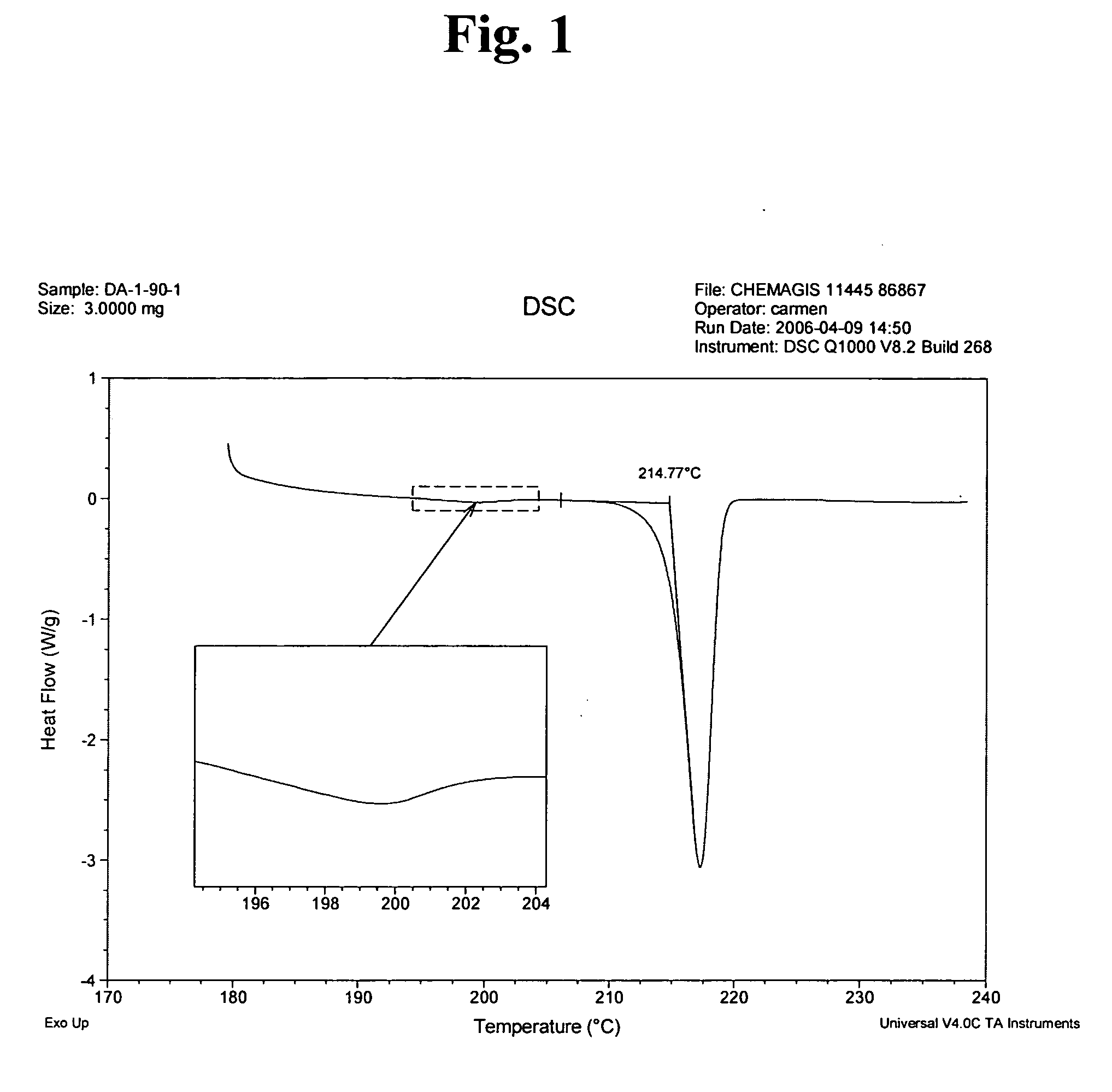Imatinib mesylate alpha form and production process therefor
a technology of mesylate and imatinib, which is applied in the field of imatinib mesylate alpha form and production process therefor, can solve the problems of not being reproducible or viable on an industrial scale, cumbersome process, and inability to use chlorinate solvents in industrial implementation, etc., and achieves the effect of suitable for pharmaceutical compositions
- Summary
- Abstract
- Description
- Claims
- Application Information
AI Technical Summary
Benefits of technology
Problems solved by technology
Method used
Image
Examples
example 1
[0040] A three-necked reaction vessel equipped with a thermometer, a reflux condenser and a mixer was charged with 0.505 gram of imatinib base (1.02 mmoles) under nitrogen atmosphere and mixed with 48 ml of methyl ethyl ketone. The mixture was heated to 75-77° C. until a clear solution was obtained, which was seeded with 25 mg of imatinib mesylate α-form. 69 μL (1.02 mmoles) of methanesulfonic acid were mixed with 5 ml of methyl ethyl ketone to form a solution, followed by slow addition of the thus formed methanesulfonic acid solution to the seeded solution of imatinib base during 2 hours. At the end of the addition the thus formed suspension was cooled to room temperature and the resulting crystals were filtered and dried under reduced pressure to obtain 0.51 g of imatinib mesylate α-form in 86.5% yield. The purity was determined by HPLC (98.8%).
example 2
[0041] A three-necked reaction vessel equipped with a thermometer, a reflux condenser and a mixer was charged with 0.505 gram (1.02 mmoles) of imatinib base under nitrogen atmosphere and mixed with 48 ml of methyl ethyl ketone. The mixture was heated to 75-77° C. until a clear solution was obtained. 69 μL (1.02 mmoles) of methanesulfonic acid were mixed with 5 ml of methyl ethyl ketone, followed by slow addition of the acid solution during 2 hours. After addition of 30% of the acid the solution, which was still clear, was seeded with 25 mg of imatinib mesylate α-form. At the end of the addition the thus formed suspension was cooled to room temperature and the resulting crystals were filtered and dried under reduced pressure to obtain 0.52 g of imatinib mesylate α-form in 88% yield.
example 3
[0042] A three-necked reaction vessel equipped with a thermometer, a reflux condenser and a mixer was charged with 1.01 gram of imatinib base (2.05 mmoles) under nitrogen atmosphere and mixed with 20 ml of methyl isobutyl ketone. The mixture was heated to 65° C. and seeded with 50 mg of imatinib mesylate α-form. 375 μL of methanesulfonic acid were mixed with 30 ml of methyl isobutyl ketone to form a solution, and 11.1 ml out of this solution (2.05 moles) were slowly added to the seeded solution of imatinib base during 4 hours. At the end of the addition the thus formed suspension was cooled to room temperature and the resulting wet crystals were filtered and dried under reduced pressure to obtain 1.085 g of imatinib mesylate α-form in 92% yield. The purity was determined by HPLC (99.4%).
PUM
| Property | Measurement | Unit |
|---|---|---|
| temperature | aaaaa | aaaaa |
| temperature | aaaaa | aaaaa |
| temperature | aaaaa | aaaaa |
Abstract
Description
Claims
Application Information
 Login to View More
Login to View More - R&D
- Intellectual Property
- Life Sciences
- Materials
- Tech Scout
- Unparalleled Data Quality
- Higher Quality Content
- 60% Fewer Hallucinations
Browse by: Latest US Patents, China's latest patents, Technical Efficacy Thesaurus, Application Domain, Technology Topic, Popular Technical Reports.
© 2025 PatSnap. All rights reserved.Legal|Privacy policy|Modern Slavery Act Transparency Statement|Sitemap|About US| Contact US: help@patsnap.com



